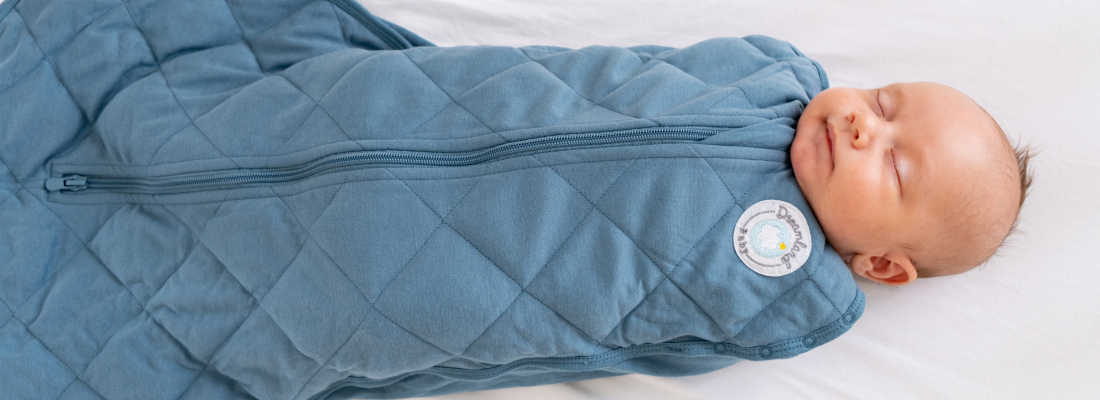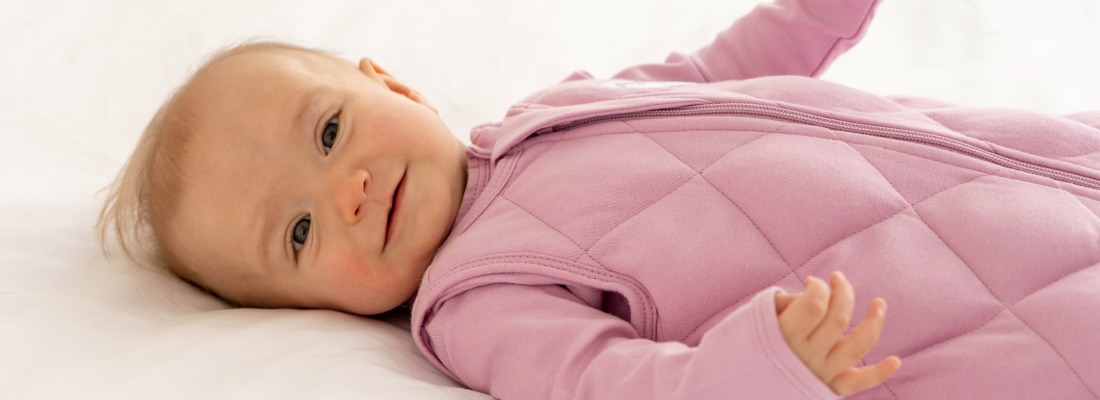Infants are new to the whole thermal regulation thing. Keeping a room too hot or too cold could be dangerous for their developing systems. Babies’ temperatures tend to fluctuate more than adults, meaning they may have a harder time staying at a comfortable temperature throughout the night. (1) Keeping our babies comfortable, and safe, is among our top priorities as parents. Keep reading to learn how to keep your baby warm at night (safely), and what could happen if your baby overheats.
How do I keep my baby room warm at night?
Ensuring that your baby stays warm throught the night not only keeps them safe and comfortable, but also may help them slep better! The easiest way to ensure a consistently warm temperature in your baby’s room is to set the home thermostat. A comfortably warm temperature for your baby is between 70-72 degrees fahrenheit. If you do not have central heat and need to warm up your baby’s room, fireproof space heaters may be an option. It is generally best to avoid space heaters (if possible) as they can be dangerous, especially in a baby’s room. If you must use one, ensure that it is placed far away from your baby’s reach and any loose fabric such as blankets or curtains. Newer model space heaters may have a “cool to the touch” feature for added safety. (2)
How do I know my baby is warm enough at night?
If your baby is peacefully asleep, chances are they are comfortable and warm enough. Babies are pretty good at letting their parents know when something is bothering them. If your baby is waking often or crying excessively, double check that their environment is warm enough - but not too warm.
Do babies get cold easily at night?
As we mentioned earlier, young babies lack the ability to effectively regulate their thermal temperature. It is much easier for babies to lose body heat more rapidly, getting cold much easier, than it is for adults or older children. Additionally, young babies have a larger body mass vs weight ratio. This means that babies are at a greater risk of losing heat than adults. (4)
What if my baby is too cold at night?
Getting too cold can be dangerous for your baby. Infants have an increased chance of developing hypothermia due to their low muscle mass. Symptoms of hypothermia include shivering, pale skin, and slow breathing. Hypothermia is life threatening, but typically only develops in extreme conditions. Natural, thermal regulating fibers such as bamboo are perfect for layering up in cooler weather.
(5)
How can I keep my baby warm at night without heating?
If you do not have access to a central or portable heat source, there are still ways that you can ensure your baby stays warm and comfortable.
Dress accordingly. Typically, you want to dress your baby much like you would dress yourself - but add one light layer.
Sleep sacks or swaddles. Traditional swaddling is considered safe until your baby begins to roll over. At that point, you can transition to a sleep sack for warmth and comfort. Pay attention to TOG ratings while shopping. The higher the TOG, the warmer the material will keep your baby.
Sleep in the same room. Body heat can increase the temperature of the environment. The AAP recommends sleeping in the same room, but not in the same bed.
What happens if a baby is too warm at night?
While we want our babies to be warm and cozy, you never want them to get too warm. According to the AAP (American Academy of Pediatrics), overheating can be a risk factor for SIDS (sudden infant death syndrome). Additionally, overheating can be extremely uncomfortable and cause sleeplessness and irritability. Here are some signs of overheating to watch out for:
- Their skin is warm. If you gently place a hand on your baby’s uncovered skin and it feels warm to the touch, they could be overheating.
- Their skin is red. Redness can happen for a multitude of reasons, especially on sensitive newborn skin. One of those reasons is being too warm.
- Lethargic. If your baby is difficult to wake or seems unresponsive, they could be dangerously too warm.
- Increased heart rate. A fast beating heart can be a symptom of overheating. A fast heart rate could indicate that their body is working hard in an effort to cool itself.
Always speak with your doctor about if and when to seek assistance if you baby experiences any of the above symptoms. Overheating is dangerous and should be prevented at all costs.
If you suspect that your baby gotten uncomfortably warm, bring them into a cooler room, place them in lighter clothes, and offer fluids.
(3)
What is a normal body temperature for a baby at night?
A healthy temperature range for a baby at night may fall anywhere between 96.8 degrees F and 100.3 degrees F. Temperatures may fluctuate throughout the day depending on activity levels, general wellness, and other factors. The method used to take a baby’s temperature can produce varying results as well. The most accurate temperatures are taking rectally with a thermometer. Anything below 95 degrees F warrants an urgent healthcare visit.
(6)
Conclusion
Getting through the cold months with a new baby can be difficult, but also, think of all those warm baby snuggles! If you just keep in mind that babies are comfortable in a similar environment to which adults would be comfortable, and maybe add a light layer, keeping your baby safe and comfortable should be easy. Dreamland Baby prioritizes safety as well as convenience - which is why we have multiple TOG rates products available. For warmer months, when your baby could use a light, breathable layer for sleep, reach for a 1.0 TOG sleep sack, swaddle, or transitional swaddle. 1.0 TOG rated sleep essentials are great for winter months too, but you may want to add an extra layer underneath depending on how cold it gets in your baby’s sleep environment. For a warmer material, grab a 2.5 TOG sleep sack or swaddle. All of our sleep essentials are made with either 100% natural cotton or bamboo for optimal breathability, thermal regulation, and comfort.
Sources:
- https://www.summerhealth.com/blog/newborn-temperature-fever#:~:text=Babies%20have%20a%20hard%20time,their%20body%20temperature%20to%20fluctuate.
- https://www.sealybaby.com/sleep-time-blog/baby-its-cold-outside-keeping-babys-nursery-warm-and-cozy/#:~:text=Set%20the%20thermostat%20for%2070,as%20possible%20to%20avoid%20overheating.
- https://happiestbaby.eu/blogs/baby/baby-overheating#:~:text=Signs%20of%20Overheating&text=Your%20baby's%20skin%20is%20red,baby%20is%20lethargic%20or%20unresponsive
- https://infantcpr.com/blog/posts/is-my-baby-too-cold-at-night/
- https://www.pregnancybirthbaby.org.au/amp/article/babies-in-cold-weather
- https://www.healthline.com/health/parenting/baby-temperature-low


